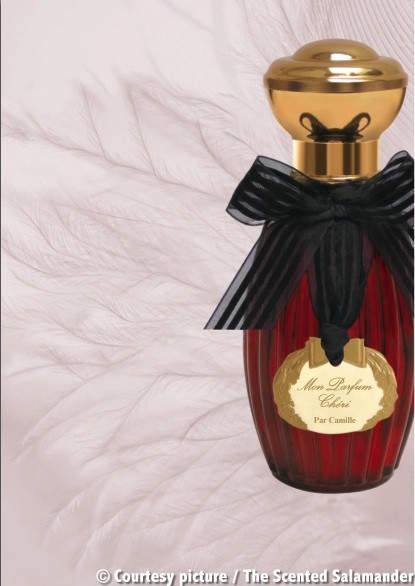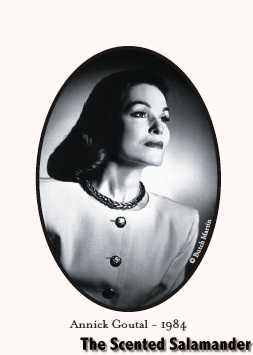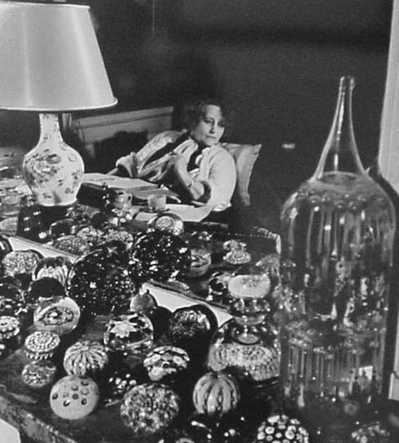Annick Goutal Mon Parfum Chéri par Camille (2011): The Thickness of Memory & Perfume {Fragrance Review}

The whiff that escapes from the burgundy-colored bottle of Mon Parfum Chéri par Camille (My Darling Perfume by Camille), to be soon exclusively launched at Harrods in London on July 1st, 2011, is very much reminiscent of old-school perfumes laden with oakmoss. It smells slightly musty, but in a chic way.
Upon spraying the perfume onto the skin, what you get is a different sensation, one which is more iris-y, suede-like. It's a comingling of soft, powdery and root-y iris with sweet Coca-Cola-like amber and mineral, graphite-like, smoky Indonesian patchouli. Musk is present, enveloped by the other notes, never overly of the unbathed persuasion, although it is not clean and white.
 The house of Annick Goutal announced the perfume as a reconstitution of an old formula, one that is that of a concrète offered by sensualist French writer Colette (1873 -1954) to the founder of the brand Annick Goutal (1946 -1999). It is a project very much rooted in nostalgia and filial love as the concrète can be seen as a baton passed on from Annick to Camille and back. Camille, the daughter of Annick, wanted to mirror the offering of her mother, the perfume Petite Chérie, in this altogether different fragrance, Mon Parfum Chéri par Camille. The composition is created to "honor the eternal beauty of her mother." There are no links except in names and intention, and perhaps via two fruit notes, pear for the first and plum for the second. Other than that, it is like contrasting two separate worlds of taste: a fresh fruity floral and a woody-floral chypre. And while usually the brand does not hesitate to feature their in-house perfumer Isabelle Doyen, this time Camille insisted on making her signature part of the name of the perfume.
The house of Annick Goutal announced the perfume as a reconstitution of an old formula, one that is that of a concrète offered by sensualist French writer Colette (1873 -1954) to the founder of the brand Annick Goutal (1946 -1999). It is a project very much rooted in nostalgia and filial love as the concrète can be seen as a baton passed on from Annick to Camille and back. Camille, the daughter of Annick, wanted to mirror the offering of her mother, the perfume Petite Chérie, in this altogether different fragrance, Mon Parfum Chéri par Camille. The composition is created to "honor the eternal beauty of her mother." There are no links except in names and intention, and perhaps via two fruit notes, pear for the first and plum for the second. Other than that, it is like contrasting two separate worlds of taste: a fresh fruity floral and a woody-floral chypre. And while usually the brand does not hesitate to feature their in-house perfumer Isabelle Doyen, this time Camille insisted on making her signature part of the name of the perfume.
"It all started with a precious present stowed away in their office : a small concrete that the author Colette gave to Annick Goutal. A woody, timeless fragrance that has survided decades with no signs of aging. Camille, obsessed with this unusual fragrance, was drawn back to her childhood memories of Hollywood's wartime movies. Tempting satin. Delicate lace. Actresses and their gloved hands and ruby lips. And a memory of her mother dressing for an evening out." ...
Colette as one of the actors of this perfume recreation, we can try to better understand in her relationship to her gesture of offering a perfume token. The writer has always had a foot in the world of beauty and fragrance, not only by taste but also for professional reasons as her road to emancipation went through her early experience as an exotic dancer who needed her pans of makeup and bottles of scent like every other show girl. Later on, she would try to use her expertise and de facto serious interest for all things beauty to try to become an entrepreneur, creating her own scents and opening a beauty parlor. But the endeavor was short-lived. She was also a beauty writer, often a complacent one, trying to push products in women's magazines where her friendly tone was always and unwaveringly warm. She was in fact a great PR. If you pay attention to the writer's face from the perspective of a beauty fiend, you cannot help but notice her dark, smoky eyes lined with black khol, her slim lips wearing an insistent swipe of rouge. Into her old age, she never let go of her coquettry.
She also apparently liked to offer little presents as mementos of her to people who came to see her. Truman Capote recounts at one point how he visited her in her appartment in Paris and left with one of the paper-weights she collected, which he saw strewn on her bed and/or besides it, I can't recall exactly. They inspired her with their imprisonned motifs. Her philosophy of gift-giving which she imparted to Capote was that one ought to give only what one treasured personally. The fact that Annick Goutal was the recipient of a similar gift in perfume form confirms this habit of hers and invites us to think that Colette loved the perfume she gave away.
Mon Parfum Chéri, whose name seems to also quote the Chéri series of novels by the writer, just like it does the perfume Petite Chérie, is an evocation of a bygone era when certain olfactory palettes dominated the scene in typical fashion. If today, the rose-ambery-patchouli accord of Narciso Rodriguez for Her is so ubiquitous, in the past, certain bases dominated.
Like a cloud of dusting powder settling in from the past, Mon Parfum Chéri once was a contemporary smell and now is a nostalgic one. Without resorting to fragrant narration, the revived composition is content with being a mark left by actions which took place much longer ago.This scent is their trace.
The composition is not very evolutive. It is more like a photograph of what people used to call an "odor." Using the word anew today puts the emphasis for me on its linear nuances although Jicky by Guerlain was called an "odor,' the old-fashioned term for perfume. Of course, its origin as a solid perfume influences this aspect of the recreation. Cream perfumes tend to be flatter. The scent reveals an old-fashioned palette of notes: powdery, oakmoss-y, prune-y. The plum note would give it out as a WWII-era scent, if we follow the official perfume chronology, with Femme de Rochas being the first plummy perfume to appear and to leave its mark. In reality, synthetic plum notes had already been created and even marketed in 1912 with Vague Souvenir by Guerlain.
The perfume is absolutely not airy as 21st perfumes can be. If it were to evoke any type of space, it would be that of a slightly claustrophobic drawing room whose windows are not often opened wide. Velvet cushions, tapestry ones are decorating heavy, plush couches. In an atmosphere such as this one, time stands still.
There is therefore something immobile about the revitalized Mon Parfum Chéri. It could be the smell coming from the bottom of an abandoned bottle. It could be the scent lingering in an old handbag. It is, we know, that, the leftover aroma of a solid perfume.
This is definitely a perfume for nostalgists. From the perspective of a history of smells, it is noteworthy to see how patchouli is used to recreate this slightly smoky, opium-den-like and musty impression of ancient perfumes choke-full of oakmoss. The humus of patchouli replaces the humus of oakmoss.
Looking back, one might be struck by the evolution in fashion tastes. Why did people think that women smelling of dusty old books, almost, could smell seductive? This is a rhetorical question, because I don't have a problem imagining why it might be seductive. The perfume forces us to change our myopic view of pleasantness and sexiness. The touch of fruit which is present with the dark, Chinese prune, draws a link to present-day taste for fruity florals, but this is a fruit which is dry, discreetly plummy rather than bursting with juice and freshness.
In a sense Mon Parfum Chéri can be seen as an anti fresh scent. Air, water, have been evacuated from the palette of notes. What we are left with is smoke, ashes, dust, a powdery cheek, a hint of mold. But there is something else, which is a certain sense of chic. It signs a certain type of elegant presence. The brand wanted to recreate what the perfume evoked for them: Old Hollywood glamor, a makeup accord. They included iris, violet and heliotropin notes to that effect.
Personally, I feel that Mon Parfum Chéri is more chic than glam, thus more Parisian than Hollywoodian. The perfume does not really thrum at my heart strings because I find it too antiquarian in spirit and I don't usually tear up in front of a museum display, but it can offer a fairly authentic vintage charm. I am sure that the perfume being related in Camille Goutal's mind to a memory of her mother, this would be much more moving to her.
At any rate, it is an artifact worth experiencing and amateurs of the genre might feel very happy indeed that there is a revivalist vintage perfume launched. Besides, you can always use it as a reminder of Colette too, as you read her today.
Notes: Indonesian patchouli, iris, violet, heliotropin.
Mon Parfum Chéri will be more widely distributed from September 1, 2011. Until then, it's in Harrods from July 1st.











